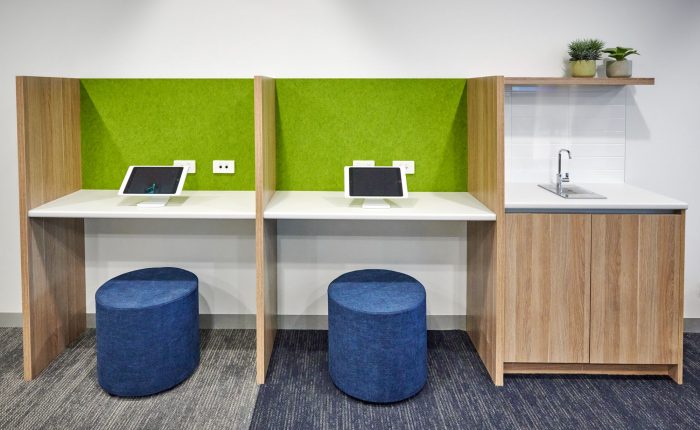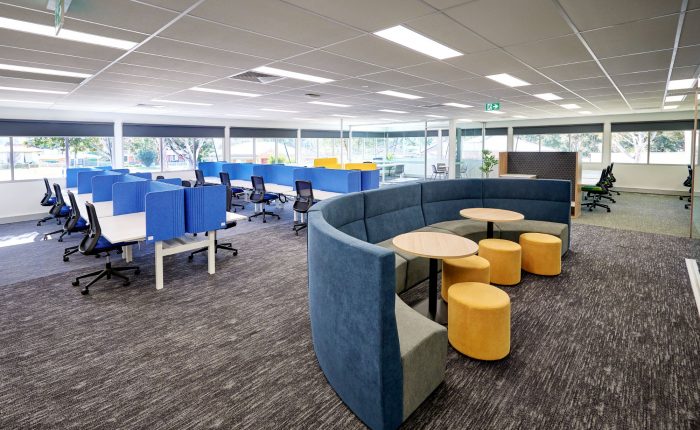Increasingly, smart businesses are championing strategic design and construction to produce a high-performance workplace. These progressive organisations understand that effective workplaces improve productivity, reduce spatial expense, and transform staff experience, thereby creating space for innovation and improvement in market positioning.
High Performing Workplaces:
- are up to 12% more productive profitable than their peers
- are up to 25% more innovative at creating and producing new products and services
- are up to 23% better at retaining employees than their low-performing peers
Stats from hpw.org.au
But these key organisational improvements don’t just happen. They are achieved through a solid workplace strategy, executed well.
So what’s the golden ticket to a high-performance workplace? How do you create workplaces that work? What are the hacks to a productive workplace?
Culture + Collaboration + Connection

Regrettably, there is no hack for high performing workplaces. Various studies disclose though hallmarks to high-performing workplaces.
Culture.
Gensler’s Workplace Survey last year revealed that the top innovative companies have a workplace culture that empowers employees to choose where and when to work based on their needs and the work they need to accomplish.
Their workplaces are a tangible display of a clear and deep understanding of their organisational goals and how each part of the business intersects to triumph these goals into the future.
Whilst there is no easy one-size-fits-all strategy, by getting a full grasp of the trends in the continuing evolution of the workplace environment, companies can reach out to a partner who has had the experience to drive such positive change in the workplace like Wurkspace7. Workspace design alone no matter how good is not sufficient to change an organisation’s culture.
Collaboration.
The same Gensler’s Survey found that second thing that top innovative companies have in common is that they provide well-designed workplaces with diverse spaces for collaboration as well as for individual focus. They also had access to amenities such as cafeterias, outdoor spaces, gyms and child care facilities.
This is why so many companies are opting to capitalise in quality workspace design, particularly activity-based work environments (ABW). ABW is found to give workers a key benefit: more picks about where and how they complete their work.
This free choice drives not only better individual efficiency, but also increases in collaboration and creative thinking leading to innovation.
Connection.
With the office becoming less and less of a workplace, the shift towards blurring the line between work and home is unprecedented. Becoming more prevalent is the collegial feel, understandably aimed at retaining millennials. There is also the move towards the ‘bleisure’ concept.
Apparently, it’s not just the lines between home and work that is being disrupted but also the lines between work and leisure. As business mixes with leisure, high performing workplaces seamlessly integrate social spaces with workspaces to make way for ‘serendipity corners’ and ‘chance-encounter corridors’. These are workplace design subtle social embedded architecture making use of technology such as laptops, mobiles and tetherless working allow people to move more freely yet stay connected within a building.
Wurkspace7 is committed to aligning your organisation’s culture + collaboration + connection. Let us help you create a high performing workplace that engages the whole individual.
https://www.business.com/articles/how-tech-giants-are-shaping-the-workplace-of-tomorrow/
http://www.facilitiesnet.com/commercialofficefacilities/article/Collaboration-Connection-Hallmarks-Of-HighPerformance-Office-Space–17119
http://www.gartner.com/it-glossary/high-performance-workplace
https://www.serraview.com/3-components-of-the-high-performance-workplace/
https://www.slideshare.net/JLL/global-workplace-strategy-trends-2015
Gensler’s 2016 Workplace Survey
http://www.hpw.org.au/services.html
http://worldmanagementsurvey.org/
http://www.techradar.com/news/world-of-tech/management/the-concept-of-bleisure-and-how-tech-giants-organise-their-workspace-1262703



